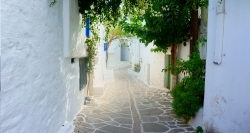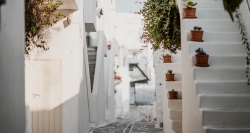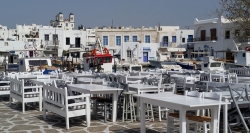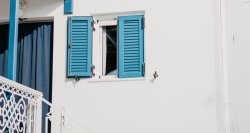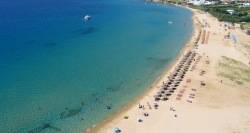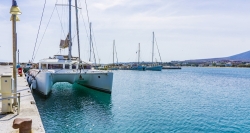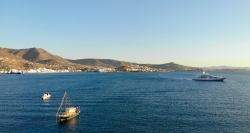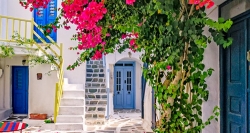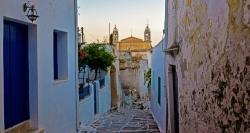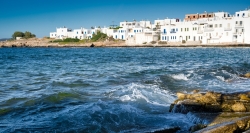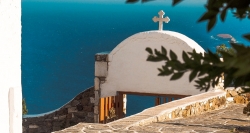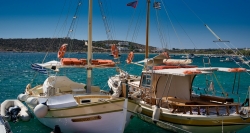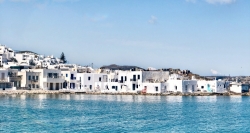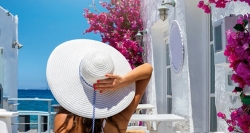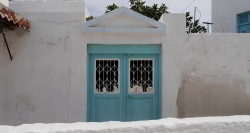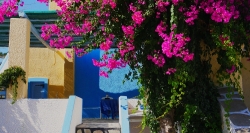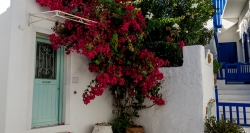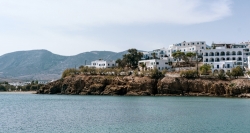Le nostre destinazioni più richieste
I nostri tour:
Common description
The heart of the Cyclades
At the center of the Cycladic archipelago, west of Naxos, here is the heart of the Cyclaid islands: Paros.
It is the fourth largest island in the archipelago. Paros, with its fishing villages, the little churches perched on the rolling hills and the scent of jasmine in the narrow alleys of the villages has an ancient charm. The beaches and coves are surprising, with the sea fading in colors from emerald to turquoise, caressed by the dry wind of the Meltemi, characteristic of the Aegean Sea.
The white of the lime-plastered houses and the blue of the domes reflect the magical and dazzling light of the sun. Unlike Mykonos, in Paros there are numerous villages by the sea and not far from the coast. The Venus de Milo and the tomb of Napoleon Bonaparte were sculpted with the marble extracted from its quarries.
Unparalleled natural beauty, beaches with crystal clear waters, unparalleled Byzantine paths connecting traditional villages and breathtaking landscapes make Paros one of the most loved tourist destinations in Greece
What to do and what to see in Paros
• Parikia, the capital of Paros, is a beautiful Cycladic village with whitewashed cubic houses and impressive neoclassical buildings. A well-preserved 13th-century Venetian castle stands proudly on a hill in the center of the village offering stunning views of Parikia. In the capital you can also admire an important ecclesiastical monument, the 6th century church of Panayia Ekatontapyliani, also called Katapoliani. The name "Ekatontapylianí" means the church with 100 doors ("Ekato Pyles" in Greek), one of which is secret! Don't miss the opportunity to visit the baptistery (4th century AD), one of the best preserved baptisteries in the Orthodox East, and the Byzantine Museum. The Byzantine Museum of Parikia is housed on the ground floor of the church. Its exhibits include icons, wood-carved iconostasis and other relics from various monasteries and churches on the island.
• The Archaeological Museum displays finds from the island's monuments (such as the Sanctuary of Asklipios and Pythios Apollonas, Delion etc.), including a part of the "Parian Chronicle", a chronological table from the 3rd century BC with references to important events and personalities of antiquity.
• The Marathi marble quarries, where the famous Parian marble was mined, were in operation from the 3rd millennium BC until the 19th century. The mining tunnels and the remains of industrial buildings from the 19th century are still preserved and can be visited
The villages of Paros
• Stroll through beautiful traditional villages such as Naoussa, a colorful village, where the ruins of a Venetian fortress stand at the entrance to its small port. Lefkes is located at the highest point of Paros and enjoys breathtaking views of the island. The village is located in the mountains and is surrounded by a rich green landscape. It has very well preserved Cycladic and neoclassical buildings, beautiful squares and narrow marble alleys. The Museum of Aegean Folk Culture in Lefkes offers a tour of the archipelago's culture; discover the world of the Aegean through its exhibitions, which include pieces related to the architecture, traditional crafts and geology of the islands.
• Marpissa, founded in the 15th century, is a traditional village with a distinctive medieval character. It is located on a hill, a few kilometers from the famous beaches of Logaras and Pisso Livadi. You can also visit the impressive Agios Antonios Monastery (17th century) on Kefalos Hill, where the ruins of a 15th century Venetian castle are located, and enjoy splendid views of the sea. Petaloudes is an area of outstanding beauty near the village of Psychopiana. The habitat is rich in vegetation and running water, with tall plane trees, laurels, wild olive trees and ivy-covered carob trees that are home to the butterfly species Panaxia quadripunstaria.
Beaches
• Sunny beaches, such as Chrissí Aktí, Santa Maria and Poúnda, welcome sun-loving visitors who want to enjoy the crystal clear sea, the sun or even their favorite water sports! Every year Chrissí Aktí is the venue for the World Windsurfing Championship. On the seabed of Alykí Beach, to the southwest, you can explore the ruins of an ancient city!
• Don't miss the opportunity to live an exciting experience touring the entire coast of the island by canoe or kayak! Enjoy the unusual natural landscape with impressive white rock formations at Kolymbithres Beach. Kalogeros beach, surrounded by red and green clay rocks, offers a truly effective spa for free! Cover your body with clay and let it dry in the sun; after a while rinse yourself in the sea and your body will feel softer than ever!
Walk the “strate”, the paths created by farmers to help them cross the island and transport their goods. It's like going back in history. Here are two itineraries you could try:
• The Lefkes-Prodromos Byzantine Trail, paved with marble paving stones for most of the way, takes an hour to walk. It starts from the green village of Lefkes and crosses slopes with cultivated terraces and a small Byzantine bridge. The final destination is the beautiful village of Prodromos with its impressive labyrinthine alleys.
• Starting from the village of Marpissa, with its Byzantine churches, 17th-century houses and picturesque windmills, walk towards Kefalos Hill and the monastery of Agios Antonios. Going up the cobblestone path, you will come across the ruins of the Venetian city of Kefalos and the Castle. At the top, enjoy views of the eastern part of the island and visit the Agios Antonios Monastery with its gold-leaf carved wooden iconostasis.
Alternatively, you can discover the island on horseback! There are two horse riding centers, one by the sea, in Ambelas, and one in Ysterni. Cycle along the coast, along sandy beaches or take a detour inland – a great way to see some of the island's most beautiful sights for yourself!
Traditions
Religious holidays are the perfect occasion for many types of celebrations! If you find yourself at such an event, don't forget to taste the fragrant wines produced in the island's vineyards. Paros is in fact one of the oldest wine-growing areas in the Mediterranean, with its wines with a protected designation of origin! Another perfect opportunity to visit the island is during the celebrations of August 15, when cultural events are organized around the church of Panayia Ekatontapyliani.
In autumn locals pay homage to their "rakidia", a locally produced spirit, and the celebrations culminate in the festival of Agios Georgios Methistis, when the new wine produced that year is uncorked for the first time.
Extra tip: Don't miss the opportunity to visit the small islet of Antiparos, located southwest of Paros, which can be easily reached from Pounda or Parikia by boat. The Hora (main town) of Antiparos is built around a 15th-century Venetian castle.
The stone-paved streets, whitewashed alleys, houses decorated with lush pink and purple bougainvillea and the central square in the shade of eucalyptus trees create an enchanting atmosphere. On the hill of Agios Ioannis there is the cave of Antiparos, characteristic for its wonderful formations of stalagmites and stalactites, while the sun-kissed beaches will offer you unforgettable moments of serenity
How to reach Paros
Where it is: in the Cyclades Islands
How big it is: 197 sq km, about 8000 inhabitants.
How to reach it:
Paros is connected by ferry to Piraeus and the rest of the Cyclades. You can reach Paros by plane from Athens and Thessaloniki airports.
More information, useful advice and curiosities in the travel documents that will be sent before departure.
At the center of the Cycladic archipelago, west of Naxos, here is the heart of the Cyclaid islands: Paros.
It is the fourth largest island in the archipelago. Paros, with its fishing villages, the little churches perched on the rolling hills and the scent of jasmine in the narrow alleys of the villages has an ancient charm. The beaches and coves are surprising, with the sea fading in colors from emerald to turquoise, caressed by the dry wind of the Meltemi, characteristic of the Aegean Sea.
The white of the lime-plastered houses and the blue of the domes reflect the magical and dazzling light of the sun. Unlike Mykonos, in Paros there are numerous villages by the sea and not far from the coast. The Venus de Milo and the tomb of Napoleon Bonaparte were sculpted with the marble extracted from its quarries.
Unparalleled natural beauty, beaches with crystal clear waters, unparalleled Byzantine paths connecting traditional villages and breathtaking landscapes make Paros one of the most loved tourist destinations in Greece
What to do and what to see in Paros
• Parikia, the capital of Paros, is a beautiful Cycladic village with whitewashed cubic houses and impressive neoclassical buildings. A well-preserved 13th-century Venetian castle stands proudly on a hill in the center of the village offering stunning views of Parikia. In the capital you can also admire an important ecclesiastical monument, the 6th century church of Panayia Ekatontapyliani, also called Katapoliani. The name "Ekatontapylianí" means the church with 100 doors ("Ekato Pyles" in Greek), one of which is secret! Don't miss the opportunity to visit the baptistery (4th century AD), one of the best preserved baptisteries in the Orthodox East, and the Byzantine Museum. The Byzantine Museum of Parikia is housed on the ground floor of the church. Its exhibits include icons, wood-carved iconostasis and other relics from various monasteries and churches on the island.
• The Archaeological Museum displays finds from the island's monuments (such as the Sanctuary of Asklipios and Pythios Apollonas, Delion etc.), including a part of the "Parian Chronicle", a chronological table from the 3rd century BC with references to important events and personalities of antiquity.
• The Marathi marble quarries, where the famous Parian marble was mined, were in operation from the 3rd millennium BC until the 19th century. The mining tunnels and the remains of industrial buildings from the 19th century are still preserved and can be visited
The villages of Paros
• Stroll through beautiful traditional villages such as Naoussa, a colorful village, where the ruins of a Venetian fortress stand at the entrance to its small port. Lefkes is located at the highest point of Paros and enjoys breathtaking views of the island. The village is located in the mountains and is surrounded by a rich green landscape. It has very well preserved Cycladic and neoclassical buildings, beautiful squares and narrow marble alleys. The Museum of Aegean Folk Culture in Lefkes offers a tour of the archipelago's culture; discover the world of the Aegean through its exhibitions, which include pieces related to the architecture, traditional crafts and geology of the islands.
• Marpissa, founded in the 15th century, is a traditional village with a distinctive medieval character. It is located on a hill, a few kilometers from the famous beaches of Logaras and Pisso Livadi. You can also visit the impressive Agios Antonios Monastery (17th century) on Kefalos Hill, where the ruins of a 15th century Venetian castle are located, and enjoy splendid views of the sea. Petaloudes is an area of outstanding beauty near the village of Psychopiana. The habitat is rich in vegetation and running water, with tall plane trees, laurels, wild olive trees and ivy-covered carob trees that are home to the butterfly species Panaxia quadripunstaria.
Beaches
• Sunny beaches, such as Chrissí Aktí, Santa Maria and Poúnda, welcome sun-loving visitors who want to enjoy the crystal clear sea, the sun or even their favorite water sports! Every year Chrissí Aktí is the venue for the World Windsurfing Championship. On the seabed of Alykí Beach, to the southwest, you can explore the ruins of an ancient city!
• Don't miss the opportunity to live an exciting experience touring the entire coast of the island by canoe or kayak! Enjoy the unusual natural landscape with impressive white rock formations at Kolymbithres Beach. Kalogeros beach, surrounded by red and green clay rocks, offers a truly effective spa for free! Cover your body with clay and let it dry in the sun; after a while rinse yourself in the sea and your body will feel softer than ever!
Walk the “strate”, the paths created by farmers to help them cross the island and transport their goods. It's like going back in history. Here are two itineraries you could try:
• The Lefkes-Prodromos Byzantine Trail, paved with marble paving stones for most of the way, takes an hour to walk. It starts from the green village of Lefkes and crosses slopes with cultivated terraces and a small Byzantine bridge. The final destination is the beautiful village of Prodromos with its impressive labyrinthine alleys.
• Starting from the village of Marpissa, with its Byzantine churches, 17th-century houses and picturesque windmills, walk towards Kefalos Hill and the monastery of Agios Antonios. Going up the cobblestone path, you will come across the ruins of the Venetian city of Kefalos and the Castle. At the top, enjoy views of the eastern part of the island and visit the Agios Antonios Monastery with its gold-leaf carved wooden iconostasis.
Alternatively, you can discover the island on horseback! There are two horse riding centers, one by the sea, in Ambelas, and one in Ysterni. Cycle along the coast, along sandy beaches or take a detour inland – a great way to see some of the island's most beautiful sights for yourself!
Traditions
Religious holidays are the perfect occasion for many types of celebrations! If you find yourself at such an event, don't forget to taste the fragrant wines produced in the island's vineyards. Paros is in fact one of the oldest wine-growing areas in the Mediterranean, with its wines with a protected designation of origin! Another perfect opportunity to visit the island is during the celebrations of August 15, when cultural events are organized around the church of Panayia Ekatontapyliani.
In autumn locals pay homage to their "rakidia", a locally produced spirit, and the celebrations culminate in the festival of Agios Georgios Methistis, when the new wine produced that year is uncorked for the first time.
Extra tip: Don't miss the opportunity to visit the small islet of Antiparos, located southwest of Paros, which can be easily reached from Pounda or Parikia by boat. The Hora (main town) of Antiparos is built around a 15th-century Venetian castle.
The stone-paved streets, whitewashed alleys, houses decorated with lush pink and purple bougainvillea and the central square in the shade of eucalyptus trees create an enchanting atmosphere. On the hill of Agios Ioannis there is the cave of Antiparos, characteristic for its wonderful formations of stalagmites and stalactites, while the sun-kissed beaches will offer you unforgettable moments of serenity
How to reach Paros
Where it is: in the Cyclades Islands
How big it is: 197 sq km, about 8000 inhabitants.
How to reach it:
Paros is connected by ferry to Piraeus and the rest of the Cyclades. You can reach Paros by plane from Athens and Thessaloniki airports.
More information, useful advice and curiosities in the travel documents that will be sent before departure.

